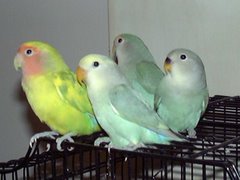SARCOCYSTOSIS IN LOVE BIRDS
Love birds are lovely pet and are preferred by many because of their attractive colour and pleasant demeanours. Like all other creatures these love birds too suffer from various disease problems and one such is sarcocystosis.
Sarcocystosis is a disease of birds that affects the love birds too. This disease is caused by parasite sarcocystis falcatula. Opossums only introduced these parasites in to the aviary. This disease doesn’t spread from bird to bird by direct contact, but the discarded infectious sporocyst can affect the healthy bird that comes in to contact. This disease is hyper acute in nature, hence the diagnosis is very difficult. Eliminating the opossums from the near by area is the best prevention method.
Sarcocystosis, this word has Greek origin. The word sarco means muscle or flesh. Sarcocyst means there is cyst in the muscle. Sarcocystis is the name of the parasite. These cysts are present in the muscle. The intermediate host species stay in the striated muscle. The intermediate stage is usually Benin stage. But the other developmental stages of the parasite in the other muscle create trouble, which in most cases results in the death of the bird.
Clinical signs of sarcocystis
The males are more prone than the female love birds. The cage mate dies all of a sudden. In most cases the other birds also get infection and die soon. But there are instances that the cage mate survives even after the death of the other bird. Prior to death the bird will have brief illness. There will dypnea, difficulty in breathing. The birds will be lethargy and there will be excretion of urates that are yellow pigmented. Clear fluid comes out of the mouth, the moment the dead bird is lifted for clearing. In some cases, the birds will appear as normal till the very second of death.
Treatment
As the diagnosis is extremely difficult, the treatment of the bird is hard to practice. However, in case the cage mate has died, the remaining bird can be protected. The drugs with antiprotozal activity can be given to the birds in various combinations. The supportive care is also should be provided along with the treatment. Pyrimethamine can be given in combination with trimethoprim-sulphadiazone, which destroys the parasite, thus protecting the bird. Pyrimethamine can be administered at the rate of 0.5 mg per kg 2 to 4 days. Then the dosage can be reduced to 0.25 mg per kg. The medication needs to be continued for 30 days. Trimethoprim-sulfadiazone is administered at the rate of 5 mg per kg by way of injection for a week.
All along the supportive care should also be provided. Supportive care is nothing but provision of gavage and oxygen. In case there is pulmonary edema, furosemide is administered by way of injection at the rate of 1.5 mg per kg.







 Free Ads For Bloggers
Free Ads For Bloggers

